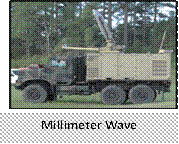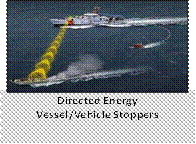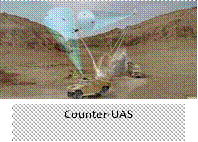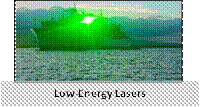
Developing a NATO Intermediate Force Capabilities Concept
Publication Type:
Journal ArticleSource:
Connections: The Quarterly Journal, Volume 21, Issue 2, p.67-84 (2022)Keywords:
Concept Development & Experimentation, cyber, Electronic Warfare, information operations, intermediate force capabilities, Non-Lethal Directed Energy, non-lethal weaponsAbstract:
<p>NATO faces a military problem: adversaries are undertaking acts of aggression that deliberately stay below the lethal force threshold or that ensure a lethal response from NATO incurring costs—undesired escalation, risks of collateral damage including civilian casualties, negative narratives, and other adverse strategic or political outcomes—to the Alliance. Intermediate Force Capabilities (IFC)—active means (non-lethal weapons, particularly non-lethal directed energy, cyber, electronic warfare, information operations, and other effectors) beyond presence but below lethal thresholds—help solve this problem. SAS-151 and Allied Command Transformation developed and conducted wargames and IFC Concept Development Workshops that demonstrated the ways in which IFC improve NATO’s ability to deter, counter, and defeat adversaries via: <em>Enhanced Engagement</em>: If fielded and incorporated into tactics, techniques, and procedures (TTPs), IFC can enable lethal engagements by isolating, stopping, or moving targets to positions of advantage, also, reversible (and in many cases unseen) effects allow for earlier employment, including potential autonomous/AI use of IFC where lethal capabilities would require human-inthe-loop; <em>Tempo/Initiative</em>: Instead of adversaries dictating the time and place of engagements, IFC help NATO gain/maintain the initiative by suppressing, imposing delays, and making adversaries reactive (even inactive); <em>Active means across the Competition Continuum</em>: NATO needs to develop, acquire, and effectively employ IFC across the continuum to win engagements, impose costs on the adversary, and win the narrative.</p>
Introduction
What Motivates the Need for an IFC Concept?
Adversaries know NATO’s lethal capabilities and the thresholds for their use. And they exploit this. They avoid direct symmetrical engagements, instead maneuvering below lethal thresholds, pursuing their aims observed but undeterred. Or, they act indirectly through proxies or intermediaries, blending in and engaging only at times and places of their choosing. They often complicate engagements, deliberately taking positions near sensitive locations (critical infrastructure, hospitals, buildings of historic or cultural importance, etc.) or near civilians to deny NATO an acceptable lethal response.
Current Hybrid and Grey Zone challenges [1],[2],[3] are a continuation of examples where adversaries exploit inadequate means, ways, or will to deter/counter, resulting in undesired outcomes, such as:
- Bridge destruction impacts [4]: Operation Deliberate Force, a NATO air campaign against the Bosnian Serb Army in August-September 1995, shortly preceded the Dayton Peace Accords. Bridges were carefully targeted to avoid casualties and collateral impact. Nonetheless, there were significant movement/ maneuver effects in subsequent NATO peace support operations and large economic and reconstruction costs in Bosnia and the region.
- Restraint and own force casualties [5]: Mazar-e-Sharif on April 1, 2011, is an apt example. In a normally peaceful area, an unexpected rush by a crowd toward the UN compound was met with no use of force. Local guards were disarmed (four were killed), and several UN officials (including LtCol Siri Skare, Norway’s first female pilot) were captured and killed.
- Failure to deter [6],[7]: Russia’s Crimea annexation and Eastern Ukraine incursions included a mix of overt and covert means—troop movements disguised with a snap exercise, distraction force ruses, use of “Little Green Men,” civilians being used to obstruct Ukrainian responses, etc.—combined with an information campaign that targeted domestic, regional, and international audiences. Current approaches to deterrence have proved insufficient even for cases where there have been repeated provocations, with examples including years of Somali piracy, repeated fast attack boat runs at vessels in the Strait of Hormuz, and disruption of operations by manned/ unmanned aircraft and simulated missile attacks in the Baltics, South China Sea, and elsewhere.
Hybrid/Grey Zone Challenges |
NATO and its members face increasing challenges from adversaries undertaking acts of aggression designed to stay below the level that would trigger a lethal response. Exploiting this, adversaries pose a dilemma: “over-reaction looks pre-emptive and disproportionate if clear responsibility for an attack has not been established, but the lack of a response leaves a state open to death by a thousand cuts.” China has achieved territorial expansion in the South China Sea, leveraging an Informationized Warfare strategy that shapes the decision-making of a target’s leadership—including through the civilian populace—to convince them not to fight. Russia’s New Generation Warfare seeks to create and make use of pro-Russian movements:
|
NATO Recognition of These Threats and Challenges
NATO faces a dangerous, unpredictable, and fluid security environment, with existential challenges and threats from all strategic directions including state and non-state actors; near-peer military forces; cyber threats; space; terrorism; hybrid warfare; and information operations.[8]
Many of these threats and challenges are highlighted in Science & Technology Trends 2020-2040 [9] and Allied Joint Doctrine (AJP-01) [10]:
- Complications in detecting, deterring, and countering indirect approaches
- Increased connection between events overseas and the homeland
- Blurring across strategic, operational, and tactical levels
- Interconnectivity across air, land, sea, cyberspace, space, and the information environment
- Widely accessible technologies (automated/autonomous systems and weaponized information activities) proliferating and being used in novel ways.
Adversaries deliberately create and exploit uncertain situations including “targeting civilian populations, institutions, and critical infrastructure.” [11]
- Acting not only directly but through proxies and intermediaries in order to achieve their goals but also to offer deniability
· Sub-threshold activities (hybrid warfare, lawfare, cyber, information operations, etc.) typically have asymmetries in the level of interest, ways and means employed, and escalation/de-escalation concerns that load predicaments and dilemmas on the Alliance:
ü Leading to a miscalculation that results in undesired escalation, even armed conflict
ü Making it difficult to gain and sustain the initiative
ü Ceding an advantage to adversaries: Russian and Chinese theories of victory emphasize seizing a decisive advantage in the early stages of conflict (initial period of war). Exploiting cyberspace, electromagnetic spectrum, and information technologies in recent conflicts has demonstrated that sub-threshold activity is a starting point for a conflict. [12]
- Positioning near sensitive locations or civilians to deny NATO an acceptable lethal response or impose costs—potential miscalculation, undesired escalation, establishment of a pretext for other adversary actions, risks of collateral damage and civilian casualties, altering the narrative, or other adverse outcomes—to the Alliance.
The 2021 NATO Summit [13] brought Heads of State and Government attention and direction:
We face multifaceted threats, systemic competition from assertive and authoritarian powers, as well as growing security challenges to our countries and our citizens from all strategic directions. Russia’s aggressive actions constitute a threat to Euro-Atlantic security; terrorism in all its forms and manifestations remains a persistent threat to us all. State and non-state actors challenge the rules-based international order and seek to undermine democracy across the globe. Instability beyond our borders is also contributing to irregular migration and human trafficking. China’s growing influence and international policies can present challenges that we need to address together as an Alliance. We will engage China with a view to defending the security interests of the Alliance. We are increasingly confronted by cyber, hybrid, and other asymmetric threats, including disinformation campaigns, and by the malicious use of ever-more sophisticated emerging and disruptive technologies.
The Communiqué of the Brussels Summit further emphasized the need to respond to hybrid threats from state and non-state actors:
In addition to its military activities, Russia has also intensified its hybrid actions against NATO Allies and partners, including through proxies. This includes attempted interference in Allied elections and democratic processes; political and economic pressure and intimidation; widespread disinformation campaigns; malicious cyber activities; and turning a blind eye to cyber criminals operating from its territory, including those who target and disrupt critical infrastructure in NATO countries. It also includes illegal and destructive activities by Russian Intelligence Services on Allied territory, some of which have claimed lives of citizens and caused widespread material damage.
Our nations continue to face threats and challenges from both state and non-state actors who use hybrid activities to target our political institutions, our public opinion, and the security of our citizens. While the primary responsibility for responding to hybrid threats rests with the targeted nation, NATO is ready, upon Council decision, to assist an Ally at any stage of a hybrid campaign being conducted against it, including by deploying a Counter Hybrid Support Team. In cases of hybrid warfare, the Council could decide to invoke Article 5 of the Washington Treaty, as in the case of an armed attack. [14]
Moreover, at the Summit, the Heads of State and Government agreed to:
- “Enhance our resilience. Noting that resilience remains a national responsibility, we will adopt a more integrated and better-coordinated approach, consistent with our collective commitment under Article 3 of the North Atlantic Treaty, to reduce vulnerabilities and ensure our militaries can effectively operate in peace, crisis and conflict.”
- “Enhance NATO’s ability to contribute to preserve and shape the rules-based international order in areas that are important to Allied security.”
The Essence of the Intermediate Force Capabilities Concept
IFC—active means (non-lethal directed energy, cyber, electronic warfare, information operations, and other relevant capabilities) delivering effects beyond Presence but below the threshold of Lethal Force—provide ways to address these threats and challenges and the stated military problem:
Military Problem: Adversaries are undertaking acts of aggression that deliberately stay below the lethal force threshold or that ensure a lethal response from NATO would incur costs—undesired escalation, risks of collateral damage including civilian casualties (CIVCAS), negative narratives, and other adverse strategic or political outcomes—to the Alliance. |
IFC are not only a needed complement to lethal force but also a facilitator. Lethal force appropriately predominates in the Intervene stage. Even in this stage, however, IFC play an important role by suppressing targets or moving/ stopping/ separating/ isolating them to ensure targets are in positions for more effective lethal engagements.
IFC offer additional benefits in other stages—imposing costs, increasing decision and action space, helping to gain/maintain the initiative, shaping and expanding the engagement space with Multi-Domain effects, etc.—delivering effective actions and outcomes where rules of engagement or target restrictions would not permit lethal force or where use of lethal force would incur costs and negative consequences for the Alliance, its members, and/or partners.
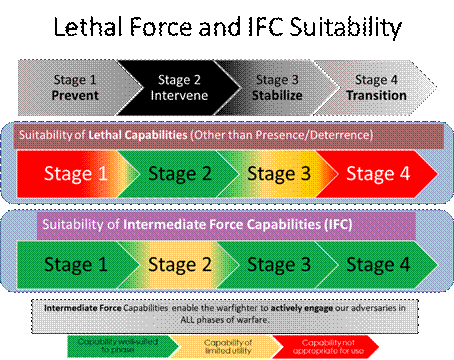
Figure 1: Utility of Lethal vs. Intermediate Force Capabilities.
Figure 2 depicts the ends, ways, and means associated with the draft NATO IFC Concept:
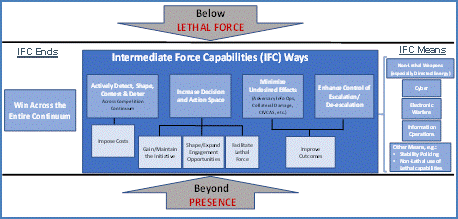
Figure 2: Ends, Ways, and Means Associated with the IFC Concept.
IFC Ends: Win across the Entire Competition Continuum
RADM Tammen in his article [15] on the NATO Warfighting Capstone Concept (NWCC) stated: “The fundamental nature of war does not change. It always involves a clash of wills, violence, friction, fog, maneuvers or deception. At the same time, the character of warfare continues to evolve and become ever more pervasive with our competitors conducting activities that sit outside the ‘normal’ peace-crisis-conflict dynamic. Major shifts in warfare are often associated with technological innovation – from arrows to black powder to battle tanks to nuclear weapons to cyber and space systems today.” IFC—non-lethal directed energy, cyber, electronic warfare, information operations, and other appropriate means—represent technological innovations essential to winning across the continuum.
Wargame results from IFC Concept Development and Experimentation are clear and compelling: IFC help win engagements, impose costs on the adversary, and win the narrative (all of which are essential).
These wargames [16],[17],[18],[19],[20],[21] compared the same scenarios for the Baseline Case (only traditional—predominantly lethal—capabilities) versus IFC Case (with advanced IFC available as a complement). The following table presents a brief excerpt of results addressing actions and outcomes with respect to escalation/ de-escalation considerations. The bottom line: With IFC, NATO was able to achieve its objectives and to block adversaries and proxies from achieving theirs.
Table 1. Sample Effects of Traditional and IFC Capabilities.
Baseline Case (Traditional capabilities only) | IFC Also Available |
“In both scenarios, escalation spun out of control.”
| “IFC turned the strategic equation on its head in favor of friendly forces.”
|
IFC Ways
The wargames [footnotes 16-21] drove insights with respect to the ways IFC solve the Military Problem:
- Actively Detect, Shape, Contest, and Deter
IFC help resolve ambiguity through active detection (including resolving ambiguity in intent); shape the environment to create more favorable conditions for further actions (including lethal if appropriate); and, finally, contest, deter or counter adversaries. This includes imposing material, financial, and/or social costs without the escalation associated with actions at the lethal force threshold. An example from the wargames was: “At the tactical level, during the naval scenario, the adversary’s attempt to use force was hampered by NATO’s use of IFC. IFC were able to deter unwanted behavior and/or degrade/disrupt the adversary’s ability to use force. By the end of the tactical game, there was little to no response from the adversary to NATO’s actions.”
- Increase Decision and Action Space
IFC help gain/maintain the initiative, shape and expand the engagement space, and facilitate the use of lethal force at times and places dictated by NATO rather than by adversaries and their proxies. In the Baseline Case, the “adversary was generally able to maintain the initiative and demonstrate an aggressive stance toward friendly forces.” Friendly forces were reactive, which often led to either uncontrolled escalation or a lack of friendly action, in both cases creating a situation favoring the adversary at the strategic level. In the IFC Case, NATO seized the initiative and decided when and how to use force, including lethal. “Consequently, the adversary force became more reactive in their actions during the naval wargame” and “By the end of the tactical game, there was little to no response from the adversary to NATO’s actions.”
- Facilitate Lethal Engagements
IFC can move/stop/separate/isolate/ suppress targets, enabling engagements at a position of advantage, increasing effectiveness, and reducing risks of unintended consequences. “The land game showed that the use of IFC to suppress and degrade adversary enabled more effective and targeted lethal response.” Also, the land game showed IFC could be used to slow or stop targets, providing more efficient targeting (and more response time) with lethal engagements at the place and time of NATO’s choice limiting the threat to civilians and critical infrastructure.
- Minimize Undesired Outcomes
Undesired outcomes may result from acts of omission or commission, and either may be grievous. Acts of omission may see adversaries achieve their aims observed but undeterred or see NATO suffer material losses (particularly in light of some adversaries’ theories of victory leveraging sub-threshold activities to seize an early decisive advantage in conflict). Acts of commission may cause collateral damage and civilian casualties, harming NATO’s interests. Relevant wargame results included: in the Baseline Case, “For the land scenario, the friendly forces were pushed into using excessive force… which provided the impetus for the strategic adversary to send forces across the border and fire missiles toward a joint Host Nation-NATO base.” In the joint game the inaction and decision paralysis due to the lack of options in the Baseline Case led to a failure of the entire NATO operation. In the IFC Case, “friendly forces were able to use IFC to suppress hostile militia actions and were thus able to use lethal force more judiciously. Limited use of lethal force significantly reduced the number of civilian casualties and, more importantly, undermined the adversary’s narrative.” Both tactically and strategically, the adversary was put on the defensive.
- Improve Control of Escalation/De-escalation
One of NATO’s core tasks is Crisis Management, which calls for “an appropriate mix of those political and military tools to help manage developing crises that have the potential to affect Alliance security before they escalate into conflicts.” [22] IFC add tools for controlling escalation. Moreover, rather than a thin line separating Presence and Lethal Force, IFC offer an entire level in between. As demonstrated in the series of wargames, IFC can prevent escalation and lead to adversary de-escalation. In addition, IFC availability consistently resulted in improved outcomes with respect to NATO’s objectives.
|
|
Figure 3: Examples of IFC as Means.
IFC Means
The working definition for IFC is “Active means below lethal intent that temporarily impair, disrupt, delay, or neutralize targets across all domains and all phases of competition and conflict.” Various capabilities are consistent with this definition:
- Non-Lethal Weapons (Especially Directed Energy)
NLW are by their design IFC, providing means beyond Presence but below Lethal Force. The North Atlantic Council (NAC) issued a policy [23] defining NLW as “weapons which are explicitly designed and developed to incapacitate or repel personnel, with a low probability of fatality or permanent injury, or to disable equipment, with minimal undesired damage or impact on the environment.” Key NLW Directed Energy capabilities include:
- Millimetre Wave for long-range effects to compel the movement of individuals, deny areas and suppress targets, as well as for Counter-Unmanned Aircraft Systems (C-UAS) effects
- High-Power Microwave (HPM) and High-Power Electro-Magnetics (HPEM) for vehicle and vessel stopping, C-UAS, and other Counter Materiel applications
- Low-energy lasers, such as dazzling lasers, to warn and suppress individuals and sensors.
|
|
Figure 4: Examples of non-lethal weapons.
Based on lessons from NLW use during NATO operations as well as results from wargames, formal military utility assessment exercises in the field, and previous NATO studies,[24],[25] there are six areas where NLW contributions need to be included in concepts, all clearly and directly relevant to the draft IFC Concept:
1. Promote Compliance/Warn/Deter
2. Facilitate Engagement
3. Facilitate Manoeuvre
4. Defeat Threats Directly
5. Enhance Protection
6. Reduce CIVCAS/Collateral Damage.
- Cyber
Cyber capabilities also provide effective means beyond resence and below lethal force.
At the 2016 Warsaw Summit,[26] NATO recognised “cyberspace as a domain of operations in which NATO must defend itself as effectively as it does in the air, on land, and at sea” stating: “This will improve NATO’s ability to protect and conduct operations across these domains and maintain our freedom of action and decision, in all circumstances. It will support NATO’s broader deterrence and defence: cyber defence will continue to be integrated into operational planning and Alliance operations and missions, and we will work together to contribute to their success.” At the 2018 Brussels Summit,[27] the Heads of State and Government characterized threats and announced a Cyber Defence Pledge:
We face a dangerous, unpredictable, and fluid security environment, with enduring challenges and threats from all strategic directions; from state and non-state actors; from military forces; and from terrorist, cyber, and hybrid attacks. Russia’s aggressive actions, including the threat and use of force to attain political goals, challenge the Alliance and are undermining Euro-Atlantic security and the rules-based international order. Instability and continuing crises across the Middle East and North Africa are fuelling terrorism. They also contribute to irregular migration and human trafficking. The ongoing crisis in Syria has a direct effect on the stability of the region and the security of the Alliance as a whole. We face hybrid challenges, including disinformation campaigns and malicious cyber activities. … We have agreed how to integrate sovereign cyber effects, provided voluntarily by Allies, into Alliance operations and missions, in the framework of strong political oversight. Reaffirming NATO’s defensive mandate, we are determined to employ the full range of capabilities, including cyber, to deter, defend against, and to counter the full spectrum of cyber threats, including those conducted as part of a hybrid campaign.
- Electronic Warfare
Potential Electronic Warfare (EW) threats include systems that can detect, exploit, degrade, disrupt, destroy, and deceive communications, navigation systems, sensors, and weapons’ control systems. Moreover, Directed Energy capabilities could attack personnel or materiel.
There is overlap among EW and other IFC, including cyber and Directed Energy, with some DE capabilities categorized as NLW (Millimetre Wave, HPM/HPEM, and low energy lasers as described previously) and others (higher energy lasers, HPM/HPEM/radio frequency, and particle beam capabilities) that would be categorized as EW but not as NLW.
EW activities and capabilities are diverse. They include sensing and protection measures such as emission control and electromagnetic hardening, security, intelligence collection, and countermeasures. They include measures to contest adversaries directly via Directed Energy applications (including laser, radio frequency, and particle beam capabilities), navigation warfare, or Electronic deception, intrusion, and jamming. EW effects range from temporary deception or disruption to more enduring degradation all the way to destruction, and as such most effects are consistent with IFC, while some destructive effects may cross to the level of lethal force.
- Information Operations
Recent operations have shown it is critical not only to win engagements but also to win the narrative. Adversaries will use information operations to advance their interests and harm NATO’s. This battle for the narrative can have significant impact with respect to support from a Host Nation and its populace (affecting the mission as a whole and the status and security of forces), regional actors (and their willingness to provide proxies, base access, transit rights, financial support, etc.), and the international community (which may bring to bear their own diplomatic, informational, military or economic resources depending on their belief in the competing narratives).
Per the NATO Strategic Communications Centre of Excellence’s Strategic Communications Hybrid Threats Toolkit [28]:
The activities of potential adversaries need to be detected and monitored, to be able to assess when competition between states escalates into something more serious. Concurrently, an adversary’s ability to restrict our own freedom of action must be denied. Responses will involve a range of government measures. These need to be coordinated so that they communicate with—and influence—the right target audiences, without risking undesired 2nd or 3rd order effects.
Information Operations are used to shape the information environment to achieve Alliance objectives and hinder adversaries from advancing their own objectives. Means may include:
- Strategic Communications
- Public Affairs
- Intelligence
- Civil-military operations
- Psychological operations and military deception
- Cyber
- Electronic Warfare.
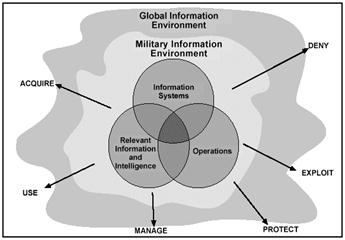 |
Figure 5: Information Environment and Operations.
- Other Means Beyond Presence and Below Lethal Intent
Capabilities develop over time or have functionality in addition to their original purpose. When such capabilities provide for effective action beyond presence while remaining below the level of lethal force, they can be legitimately considered Intermediate Force Capabilities. During IFC Concept Development & Experimentation, the Director and staff from the Stability Policing CoE highlighted Stability Policing’s relevance to the IFC Concept:
- Stability Policing (SP) and policing in general mostly operate within the IFC remit, that is, between mere presence and the use of lethal force.
- SP can counter hybrid threats and act in grey zone confrontation below the threshold of conflict. The article “How to Win an Asymmetric War in the Era of Special Forces” [29] calls for new forms of deterrence and response, with the article emphasizing roles for Special Forces but also with clear opportunities for SP to address adversary exploitation of the target population:
“Traditional deterrence, backed by large conventional formations and nuclear weapons, relies on the power to hurt an adversary by applying overwhelming force if it crosses a red line for retaliation. Russia’s New Generation Warfare and China’s Unrestricted Warfare present challenges to traditional deterrence because they use “salami tactics” that avoid triggers for conventional retaliation... Deterring gray-zone coercion requires an unconventional approach, one that addresses the vulnerabilities that the adversary exploits in the target population, as well as augmenting capabilities that will nullify the aggressor’s advantages.”
- SP through reinforcement and capability building of Indigenous Police Forces can:
- Expand the Alliance’s reach into the policing/civil remit by Host Nation (HN) invitation to support HN national and societal cohesion/ resilience, build integrity amongst Justice Sector entities (law enforcement, judiciary, corrections), and increase support from the populace
- Take action while reducing collateral damage risks (also key to provide support from the populace)
- Add flexibility by applying authorities to arrest, seize illicit funds/ materiel, use tools combat forces cannot, and combat irregular actors through offensive cyberspace operations using Sovereign Cyber Effects Provided Voluntarily by Allies (SCEPVAs) if requested by the HN judicial authority.
The wargames highlighted the importance of area denial, area clearance, vehicle stopping, and protection of facilities and forces, with IFC making important contributions in each of these areas. Provided advance notice, Military Engineering (MILENG) can make relevant contributions in all of these areas. As such, MILENG represents another potential IFC means. Finally, wargames included the employment of Lethal capabilities to achieve Non-Lethal effects (warning shots and use against open terrain and infrastructure for counter-mobility). It should be noted even where the effects were Non-Lethal as intended, adversaries assessed (and changed) their escalation-of-force calculus very differently from other IFC.
Summary and Implementation Imperatives
NATO’s 2030 Initiative [30] and Strategic Concept [31] commit the Alliance to “prevent crises, manage conflicts and stabilize post-conflict situations” and “ensure that NATO has the full range of capabilities necessary to deter and defend against any threat to the safety and security of our populations.” Given current and foreseen threats, NATO needs IFC—active means (Non-Lethal Directed Energy, Cyber, Electronic Warfare, Information Operations, and other relevant capabilities) that deliver Multi-Domain effects beyond Presence but below the threshold of Lethal Force—to realize these commitments. In support of the NATO Warfighting Capstone Concept, IFC help win across the competition continuum, with concept experimentation (wargaming) highlighting IFC contributions that build through the stages of the “Framework for Future Alliance Operations” [32]:
Table 2. IFC Contributions through the Stages of “Future Alliance Operations.”
Threats/Challenges across Stages | Ways IFC Address Threats/Challenges |
Prevent Stage: Adversaries achieve goals directly or indirectly using military and paramilitary capabilities, proxies, insurgents, and/ or civil institutions and civilians, with threats and challenges spanning Physical, Information, and Cognitive Domains. |
|
Intervene Stage: Adversaries deliberately complicate targeting by positioning near sensitive locations (critical infrastructure, hospitals, buildings of historical or cultural importance, etc.) or near civilians (blending in with the populace or intentionally using human shields). |
|
Stabilize and Transition Stages: Adversaries seek to create and exploit friction with the Host Nation Government and populace, creating and leveraging incidents to advance their aims and harm NATO’s. |
|
Wargames and IFC Concept Development Workshops also highlighted implementation imperatives:
- Enhanced Engagement: If fielded and incorporated into tactics, techniques, and procedures (TTPs), IFC can enable lethal engagements by isolating, stopping or moving targets to positions of advantage; also, reversible (and in many cases unseen) IFC effects allow for earlier employment, including potential autonomous/AI use of IFC where lethal capabilities would require human-in-the-loop.
- Tempo/Initiative: Provided IFC are available across the force and integrated into targeting, instead of adversaries dictating the time and place of engagements, IFC enable NATO to gain/maintain the initiative by suppressing, imposing delays, and making adversaries reactive (even inactive).
- Win across the Competition Continuum: NATO needs to develop, acquire, and effectively employ IFC across the continuum to win engagements, impose costs on the adversary, and win the narrative. Winning across the continuum will also require NATO to counter adversary employment of IFC.
Disclaimer
The views expressed are solely those of the author and do not represent official views of the PfP Consortium of Defense Academies and Security Studies Institutes, participating organizations, or the Consortium’s editors.
Acknowledgment
Connections: The Quarterly Journal, Vol. 21, 2022, is supported by the United States government.
About the Author
John Nelson is an international defense analyst with more than 30 years of experience. He has led many high-level planning and analytical efforts, with examples including the analysis and re-design of the First Marine Expeditionary Force’s (I MEF’s) Planning/Decision/Execution/Assessment process, which significantly increased I MEF’s planning horizon; development of the first in a series of interagency exercises (Emerald Express) on Peace Support Operations and Military Support to Civilian Authorities; development of theater-level contingency plans and organizational assessments for the Implementation Force/Stabilization Force (IFOR/SFOR) in Bosnia; leadership of American Systems work analyzing the insurgency in Iraq’s Anbar Province for the Marine Corps Intelligence Activity. Leading roles in NATO studies include the Non-Lethal Weapons (NLW) Effectiveness Assessment (SAS-060) that won a 2008 NATO Scientific Achievement Award; a Capabilities-Based Assessment (SAS-078), which received Bi-Strategic Command (Supreme Headquarters Allied Powers Europe and Allied Command Transformation) endorsement; NLW in NATO and National Concepts (SAS-094) that won a 2017 NATO Scientific Achievement Award; and SAS-151’s analysis, wargaming, and IFC Concept Development Workshops that developed a draft NATO IFC Concept. E-mail: john.nelson@americansystems.com
- 7579 reads
- Google Scholar
- DOI
- RTF
- EndNote XML


